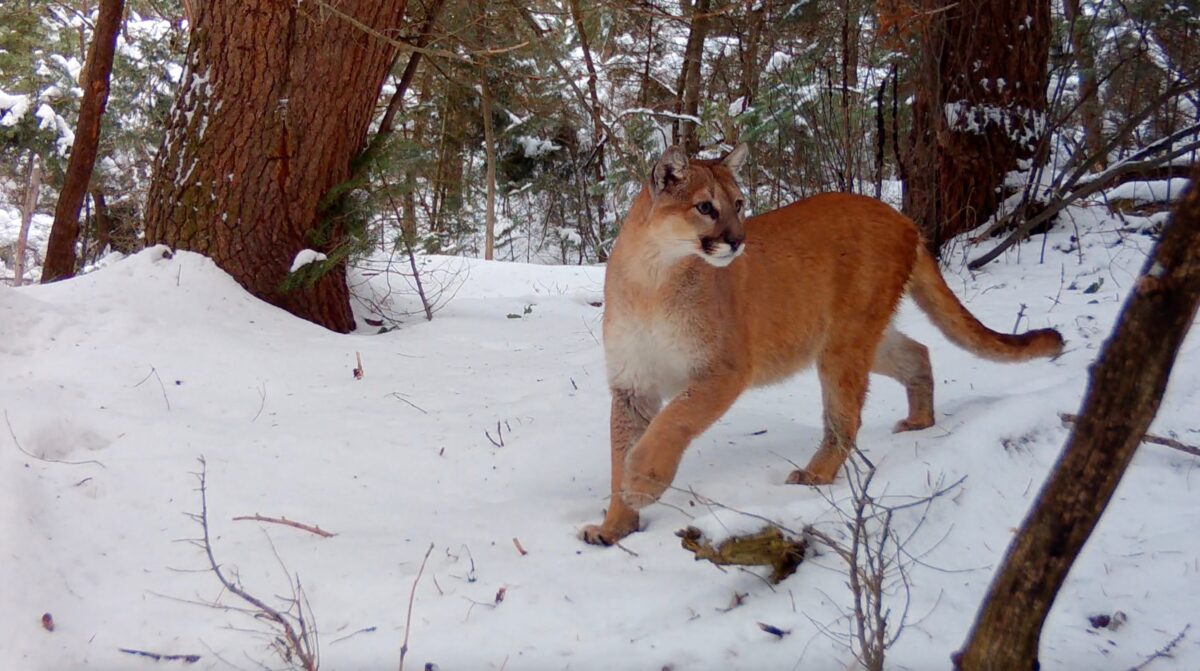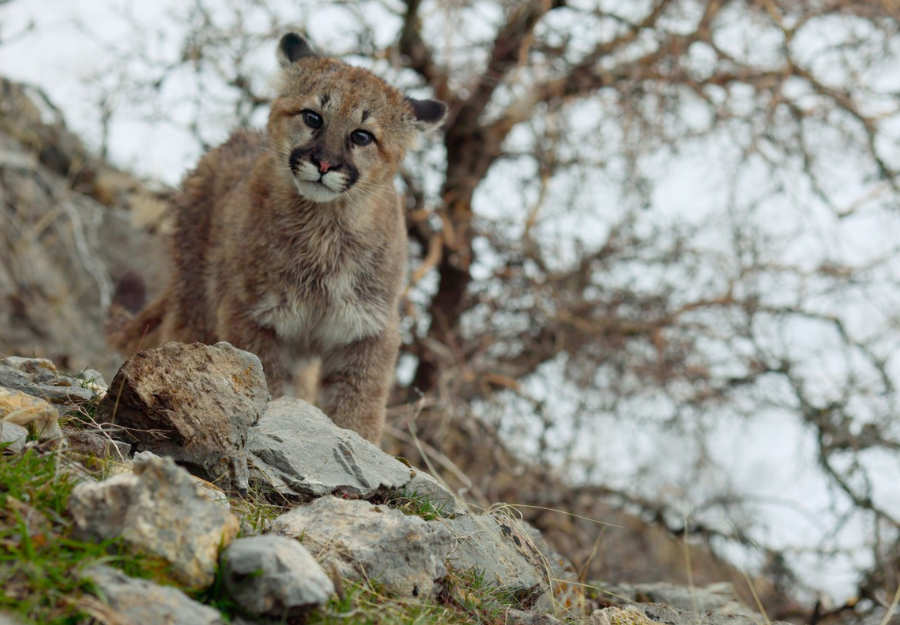Sign: Evidence of a Lion’s Presence
Seeing a lion in the wild is an especially rare occurrence. Cougars are solitary, elusive, and very stealthy. If a cougar is in the area and you are lucky enough to detect its presence, most often it will be due to “cougar sign” and not actually seeing the animal. These signs are evidence left behind after a cougar has passed through. Cougar signs include tracks, scat, scratches and cached (partially buried) prey.
When spending time in cougar country, keep an eye out for the following indications that a lion may have, at one time or another, been in the area. If scat or a deer kill appears fresh, please notify people nearby to stay off the trail, giving the lion time and space to move on.
Cougar Tracks
by Susan C. Morse (excerpt from Cougar: The American Lion)
Upon first investigating a track or tracks, step back and examine the “style” of the track sequences. By process of elimination, the tracker can usually begin to discern what the tracks probably are by identifying specific features which are either diagnostic of wild cats or domestic or wild canids (dogs).
Dog tracks usually register (show) the animal’s forward moving “style” of locomotion. Coyotes and wolves and even their domestic counterparts usually trot, and often, gallop in order to get around. The result is very diagnostic, for the heel pad will shove up the surface material into a ridqe on the top edge of the heel.
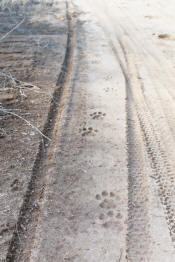
Cats usually walk through life; like their domestic cousins, they choose a very easy and deliberate walking pace with the result that their tracks typically appear clean and undisturbed, with the animal’s weight showing in an evenly distributed impression.
Don’t assume that a track automatically belongs to a dog if it has nail marks showing. Some sheep dogs and hounds have nails which are very worn with the result that they occasionally won’t show at all, whereas cougars and bobcats will occasionally use their claws for extra traction while walking upon slippery or disagreeable surfaces. The difference in what we see is significant. Cat claw marks appear as sharply defined slits in contrast to the blunt impressions of canid nails.
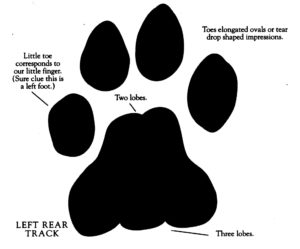
Upon further examination of a track, look for the following features: Cougar tracks feature the typical cat heel imprint, which has two lobes on the top (or leading edge) of the heel and three lobes at the base (or bottom) of the heel. Be aware that some guidebooks do not always show the diagnostic two lobes on the leading edge, while others do. Both are correct for these features may or may not appear, depending on the properties of the surface upon which the lion is walking, and the corresponding depth of his foot impressions. Most often, however, the three lobe pattern at the base of the heel will show.
The toes of a cougar track are asymmetrically arranged and appear as elongated ovals or tear drop shaped impressions. The leading toe corresponds to our middle finger, with the little toe (like our little finger) providing the sure clue as to whether it is a right or left foot we are examining.
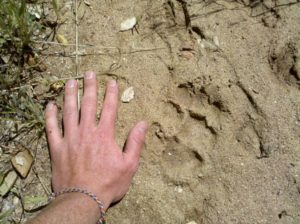
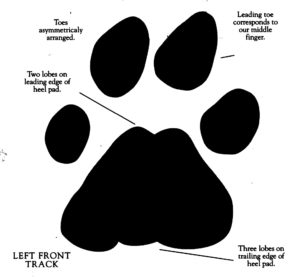 Walking track sequences of the mountain lion usually involves a direct register of tracks, if the animal is stalking or walking upon snow or a muddy surface. This means the left and right hind feet have been placed directly in the corresponding impressions made by the front feet. By contrast, an over-stepped register or slightly offset direct register occurs if the animal is walking normally. The hind foot is placed on top of or forward of the fore foot impression.
Walking track sequences of the mountain lion usually involves a direct register of tracks, if the animal is stalking or walking upon snow or a muddy surface. This means the left and right hind feet have been placed directly in the corresponding impressions made by the front feet. By contrast, an over-stepped register or slightly offset direct register occurs if the animal is walking normally. The hind foot is placed on top of or forward of the fore foot impression.
The cougar’s trail will appear as a neat, regular placement of paired or overlapped footprints, in which the left and right hind feet have been placed in or near the corresponding impressions made by the front feet. Note that unless cougars are actually stalking, playing or running away from an enemy, their trails rarely depict variations in gait.
Cougar Scat
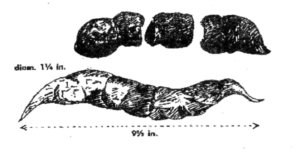 Mountain lion scat tends to be segmented with a diameter of an inch or larger. It often contains hair and bits of bone which may give it a white coloration. Mountain lions deposit their scat in prominent locations such as the middle of trails and dirt roads, along ridgelines, and near kill caches as territorial markings. This behavior is more commonly seen with males than females.
Mountain lion scat tends to be segmented with a diameter of an inch or larger. It often contains hair and bits of bone which may give it a white coloration. Mountain lions deposit their scat in prominent locations such as the middle of trails and dirt roads, along ridgelines, and near kill caches as territorial markings. This behavior is more commonly seen with males than females.
Scat used for a scent marker is commonly deposited on top of a scratch pile. With his hind feed, a cougar will scrape the ground backwards creating a small mound of dirt and leaves with a shallow hole about 8 inches long in front of it. The mound is then urinated upon and sometimes also marked with scat. Although other species of cats “spray” urine and other fluids to scent mark, cougars do not appear to conduct this behavior. Scratch piles can be found throughout a cougar’s home range but may be found more often along the borders or where his territory overlaps with another cat’s. “By advertising, an adult male may demonstrate his dominance and thereby reduce the degree of trespass by other males (both resident and new immigrants), increase his own chances of breeding with resident females, and decrease the chances his mates and offspring will be harmed. Long-term residents have the opportunity to cover an area with scent marks, giving potential intruders ample opportunity to retreat before there is a life-threatening encounter” (Logan & Sweanor, Desert Puma).
 As these scent markers are used for communication, a female ready for breeding that comes across a male’s scratch pile may also urinate on it to indicate she is in the area and looking to mate. Females with cubs are not looking to breed, and researchers often found the scat of these cougars covered within scratch mounds – a pile of one or more scats buried in leaves and soil – near a kill site. Her kittens commonly also left their scat in this “toilet.” Burying the scat might be a way to hide her scent and avoid attracting unwanted males who might harm her kittens. Males have been known to kill even their own
As these scent markers are used for communication, a female ready for breeding that comes across a male’s scratch pile may also urinate on it to indicate she is in the area and looking to mate. Females with cubs are not looking to breed, and researchers often found the scat of these cougars covered within scratch mounds – a pile of one or more scats buried in leaves and soil – near a kill site. Her kittens commonly also left their scat in this “toilet.” Burying the scat might be a way to hide her scent and avoid attracting unwanted males who might harm her kittens. Males have been known to kill even their own
Cougar Scratches
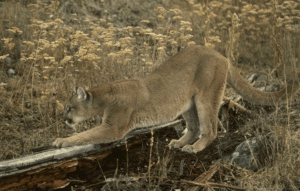
In addition to scat and urination for scent communication, cougars sometimes also leave scratch markings on tree trunks or stumps through a process called claw raking. Similar to a house cat scratching furniture, a cougar will stand on its hind legs and drag its claws down a tree trunk. The scratches will be approximately four to eight feet off the ground, depending on the size of the cat, and run parallel and vertically down the tree a few feet. Although these scrapes may simply be part of the claw-grooming process, many researchers believe it is another way for the cats to announce their presence. Scent from the paws is left behind in the tree bark and cougars have been observed sniffing the scratches made by other cats. Likely, it marks one’s territory to deter intruders and serves as a dating bulletin board for those ready to mate.
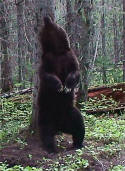
Seeing scratched bark is not a clear indication of a cougar’s presence. Bears also claw rake; their scrapes tend to be larger and remove more bark. Ungulates, like deer, elk and moose, rub their antlers against trees and can leave scratch marks, too. In preparation for rut (mating), it is common for males to scrape their antlers against tree trunks to help remove the velvet. Large mammals can also be seen rubbing their bodies against tree trunks to scratch those hard-to-reach itches.



 Facebook
Facebook Twitter
Twitter Send Email
Send Email